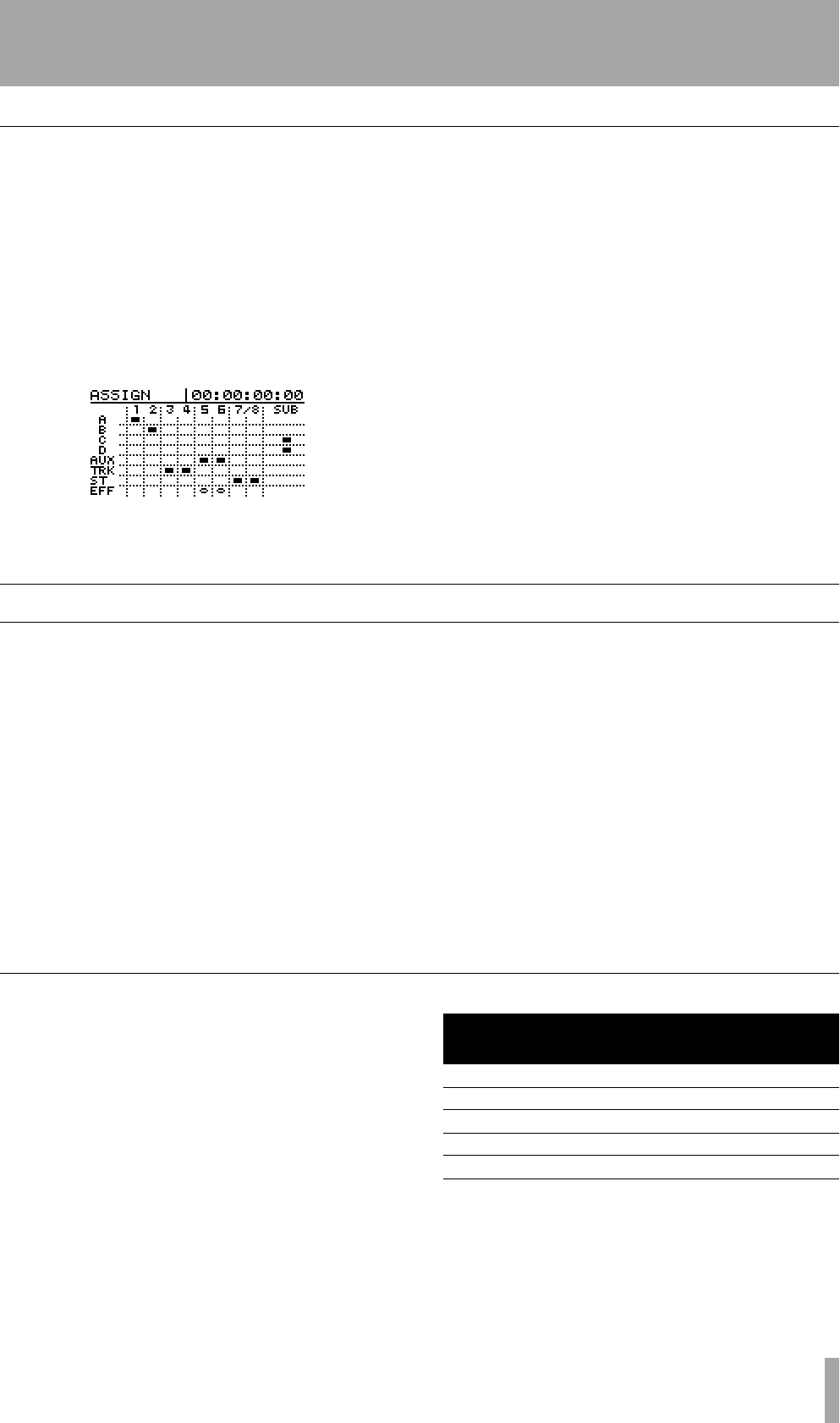
1 – Introductory concepts–Synchronization and the 788
TASCAM 788 Digital PortaStudio 15
Quick setup and the assign screen
The 788 allows you to see your current assignments
easily in two ways (as explained in more detail in
“Assignment on the 788” on page 36):
Firstly, when you press a mixer channel’s
SELECT
key, it flashes, along with the inputs that have been
assigned to it.
Secondly, to see the whole map of the current assign-
ments, press and hold down the
SHIFT key while
pressing the ASSIGN MAP key:
Inputs are listed down the left side of the screen, and
destinations along the top. A black mark at the inter-
section of the input and destination means an assign-
ment of the input to the destination.
As well as this map, the 788 also allows you to set up
different commonly-used assignment maps using the
QUICK SETUP key.
The assignment maps that you can set up in this way
are:
RECORDING (where the inputs are
assigned to the mixer channels (and hence to the
tracks on a one-to-one basis),
MIXDOWN, where
the recorded tracks are routed to the stereo output
bus, and
BOUNCE 7/8 where tracks 1 through
6 are routed to the stereo bus, which in its turn is
routed to channels 7 and 8.
There is also a special library, as described elsewhere
in this manual, where custom routing patterns can be
stored and retrieved (as well as a library for storing
the whole of the mixer’s settings).
Synchronization and the 788
One of the other key features of the 788 is its ability
to synchronize with other equipment. This is espe-
cially useful when working with MIDI equipment, as
the MIDI instruments do not actually need to be
recorded until the final mixdown stage.
Instead, one way of working is to record the basic
MIDI tracks (say a bass and drums sequence) on a
sequencer, and play it back as a guide “click” or
backing track while recording guitars, vocals, etc.
Alternatively, the acoustic tracks may be recorded
first, and MIDI tracks added later as atmosphere.
In either case, at mixdown, the 788 provides you with
a sub mix facility, that allows the inputs to be routed
through to the master stereo mix in addition to the
tracks recorded on disk.
There is no “right” or “wrong” way of working—you
should choose the method that works best for you
and your material.
Note that in either case, the MIDI must be accurately
synchronized to the acoustic recorded material at all
times.
There are three basic methods of synchronization
between the 788 and a MIDI system, briefly
explained below. Full details of how to use these syn-
chronization facilities are provided in “Synchroniza-
tion” on page 94.
Timecode synchronization
Timecode is a way of specifying an absolute position
in a recording. It is expressed in hours, minutes, sec-
onds, frames and bits. The number of frames in a sec-
ond depends on the timecode type—these are related
to the audio-visual industry where timecode (some-
times known as “SMPTE” or “SMPTE/EBU” time-
code originated. There are five major “flavors” of
timecode supported by the 788:
The 788 converts internal timecode so that it can be
transmitted over MIDI (MIDI Time Code or MTC)
and this is the way in which the 788 transmits and
receives timecode.
Frames/
second (fps)
Timecode type
24 Movie
25 PAL/SECAM TV
29.97 drop NTSC color for broadcast
29.97 non-drop NTSC color TV
30 non-drop NTSC mono TV


















